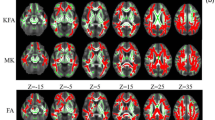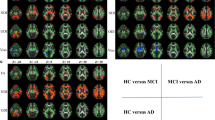Abstract
Motion artifacts are a well-known and frequent limitation during neuroimaging workup of cognitive decline. While head motion typically deteriorates image quality, we test the hypothesis that head motion differs systematically between healthy controls (HC), amnestic mild cognitive impairment (aMCI) and Alzheimer disease (AD) and consequently might contain diagnostic information. This prospective study was approved by the local ethics committee and includes 28 HC (age 71.0 ± 6.9 years, 18 females), 15 aMCI (age 67.7 ± 10.9 years, 9 females) and 20 AD (age 73.4 ± 6.8 years, 10 females). Functional magnetic resonance imaging (fMRI) at 3T included a 9 min echo-planar imaging sequence with 180 repetitions. Cumulative average head rotation and translation was estimated based on standard fMRI preprocessing and compared between groups using receiver operating characteristic statistics. Global cumulative head rotation discriminated aMCI from controls [p < 0.01, area under curve (AUC) 0.74] and AD from controls (p < 0.01, AUC 0.73). The ratio of rotation z versus y discriminated AD from controls (p < 0.05, AUC 0.71) and AD from aMCI (p < 0.05, AUC of 0.75). Head motion systematically differs between aMCI/AD and controls. Since motion is not random but convoluted with diagnosis, the higher amount of motion in aMCI and AD as compared to controls might be a potential confounding factor for fMRI group comparisons. Additionally, head motion not only deteriorates image quality, yet also contains useful discriminatory information and is available for free as a “side product” of fMRI data preprocessing.




Similar content being viewed by others
Abbreviations
- AD:
-
Alzheimer disease
- aMCI:
-
Amnestic mild cognitive impairment
- AUC:
-
Area under the curve
- fMRI:
-
Functional magnetic resonance imaging
- HC:
-
Healthy control
- MMS:
-
Mini mental state
- MRI:
-
Magnetic resonance imaging
- PET:
-
Positron emission tomography
- rs-fMRI:
-
Resting-state fMRI
- ROC:
-
Receiver operating characteristic
References
Duara R, Barker W, Loewenstein D, Bain L (2009) The basis for disease-modifying treatments for Alzheimer’s disease: the sixth annual mild cognitive impairment symposium. Alzheimers Dement 5:66–74
Fan Y, Batmanghelich N, Clark CM, Davatzikos C (2008) Spatial patterns of brain atrophy in MCI patients, identified via high-dimensional pattern classification, predict subsequent cognitive decline. Neuroimage 39:1731–1743
Fazekas F, Chawluk JB, Alavi A, Hurtig HI, Zimmerman RA (1987) MR signal abnormalities at 1.5 T in Alzheimer’s dementia and normal aging. AJR Am J Roentgenol 149:351–356
Forlenza OV, Diniz BS, Nunes PV, Memoria CM, Yassuda MS, Gattaz WF (2009) Diagnostic transitions in mild cognitive impairment subtypes. Int Psychogeriatr 21:1088–1095
Fox MD, Greicius M (2010) Clinical applications of resting state functional connectivity. Front Syst Neurosci 4:19
Haller S, Bartsch A, Nguyen D, Rodriguez C, Emch J, Gold G, Lovblad KO, Giannakopoulos P (2010a) Cerebral Microhemorrhage and Iron Deposition in Mild Cognitive Impairment: susceptibility-weighted MR Imaging Assessment. Radiology 257:764–773
Haller S, Nguyen D, Rodriguez C, Emch J, Gold G, Bartsch A, Lovblad KO, Giannakopoulos P (2010b) Individual prediction of cognitive decline in mild cognitive impairment using support vector machine-based analysis of diffusion tensor imaging data. J Alzheimers Dis 22:315–327
Haller S, Missonnier P, Herrmann FR, Rodriguez C, Deiber MP, Nguyen D, Gold G, Lovblad KO, Giannakopoulos P (2013) Individual classification of mild cognitive impairment subtypes by support vector machine analysis of white matter DTI. AJNR Am J Neuroradiol 34:283–291
Holmes C, Boche D, Wilkinson D, Yadegarfar G, Hopkins V, Bayer A, Jones RW, Bullock R, Love S, Neal JW, Zotova E, Nicoll JA (2008) Long-term effects of Abeta42 immunisation in Alzheimer’s disease: follow-up of a randomised, placebo-controlled phase I trial. Lancet 372:216–223
Ikari Y, Nishio T, Makishi Y, Miya Y, Ito K, Koeppe RA, Senda M (2012) Head motion evaluation and correction for PET scans with 18F-FDG in the Japanese Alzheimer’s disease neuroimaging initiative (J-ADNI) multi-center study. Ann Nucl Med 26:535–544
Lannfelt L, Blennow K, Zetterberg H, Batsman S, Ames D, Harrison J, Masters CL, Targum S, Bush AI, Murdoch R, Wilson J, Ritchie CW (2008) Safety, efficacy, and biomarker findings of PBT2 in targeting Abeta as a modifying therapy for Alzheimer’s disease: a phase IIa, double-blind, randomised, placebo-controlled trial. Lancet Neurol 7:779–786
Mariani E, Monastero R, Mecocci P (2007) Mild cognitive impairment: a systematic review. J Alzheimers Dis 12:23–35
McKhann G, Drachman D, Folstein M, Katzman R, Price D, Stadlan EM (1984) Clinical diagnosis of Alzheimer’s disease: report of the NINCDS-ADRDA work group under the auspices of department of health and human services task force on Alzheimer’s disease. Neurology 34:939–944
Misra C, Fan Y, Davatzikos C (2009) Baseline and longitudinal patterns of brain atrophy in MCI patients, and their use in prediction of short-term conversion to AD: results from ADNI. Neuroimage 44:1415–1422
Monsch AU, Kressig RW (2010) Specific care program for the older adults: memory clinics. Eur Geriatr Med 1:128–131
Mueller S, Keeser D, Reiser MF, Teipel S, Meindl T (2012) Functional and structural mr imaging in neuropsychiatric disorders, part 1: imaging techniques and their application in mild cognitive impairment and Alzheimer disease. AJNR Am J Neuroradiol 33:1845–1850
Nitsch RM, Hock C (2008) Targeting beta-amyloid pathology in Alzheimer’s disease with Abeta immunotherapy. Neurotherapeutics 5:415–420
O’Dwyer L, Lamberton F, Bokde AL, Ewers M, Faluyi YO, Tanner C, Mazoyer B, O’Neill D, Bartley M, Collins DR, Coughlan T, Prvulovic D, Hampel H (2012) Using support vector machines with multiple indices of diffusion for automated classification of mild cognitive impairment. PLoS ONE 7:e32441
Petersen RC (2004) Mild cognitive impairment as a diagnostic entity. J Intern Med 256:183–194
Petersen RC, Negash S (2008) Mild cognitive impairment: an overview. CNS Spectr 13:45–53
Plant C, Teipel SJ, Oswald A, Bohm C, Meindl T, Mourao-Miranda J, Bokde AW, Hampel H, Ewers M (2010) Automated detection of brain atrophy patterns based on MRI for the prediction of Alzheimer’s disease. Neuroimage 50:162–174
Power JD, Barnes KA, Snyder AZ, Schlaggar BL, Petersen SE (2012) Spurious but systematic correlations in functional connectivity MRI networks arise from subject motion. Neuroimage 59:2142–2154
Sperling R (2011) Potential of functional MRI as a biomarker in early Alzheimer’s disease. Neurobiol Aging 32(Suppl 1):S37–S43
Winblad B, Palmer K, Kivipelto M, Jelic V, Fratiglioni L, Wahlund LO, Nordberg A, Backman L, Albert M, Almkvist O, Arai H, Basun H, Blennow K, de Leon M, DeCarli C, Erkinjuntti T, Giacobini E, Graff C, Hardy J, Jack C, Jorm A, Ritchie K, van Duijn C, Visser P, Petersen RC (2004) Mild cognitive impairment–beyond controversies, towards a consensus: report of the International Working Group on Mild Cognitive Impairment. J Intern Med 256:240–246
Acknowledgments
We thank all volunteers and patients for participating in this study. This study was supported, in part, by a grant of the VELUX Foundation
Funding
The funders had no role in study design, data collection and analysis, decision to publish, or preparation of the manuscript. No current external funding sources for this study.
Author information
Authors and Affiliations
Corresponding author
Rights and permissions
About this article
Cite this article
Haller, S., Monsch, A.U., Richiardi, J. et al. Head Motion Parameters in fMRI Differ Between Patients with Mild Cognitive Impairment and Alzheimer Disease Versus Elderly Control Subjects. Brain Topogr 27, 801–807 (2014). https://doi.org/10.1007/s10548-014-0358-6
Received:
Accepted:
Published:
Issue Date:
DOI: https://doi.org/10.1007/s10548-014-0358-6




